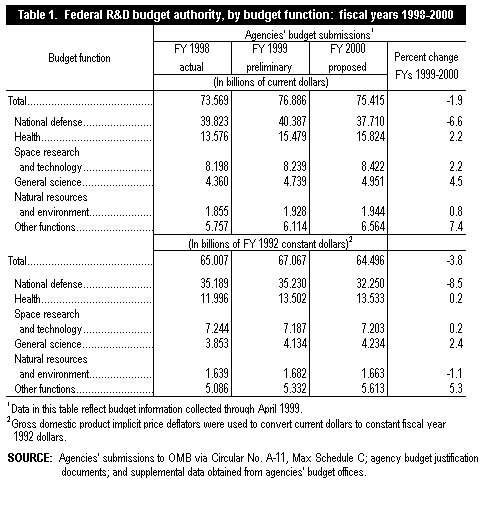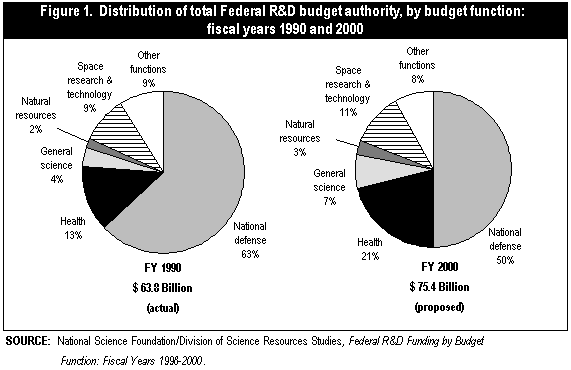| Division of Science Resources Studies | |
| DATA BRIEF | Directorate for Social, Behavioral and Economic Sciences |
President's FY 2000 Budget Includes Reduced R&D Request; Nondefense R&D Funding Catches Up to Defense R&D |
|
Throughout the 1990s, the percentage of Federal nondefense R&D funding grew and now matches the defense R&D share.
Health accounts for one-fifth of the total Federal R&D budget authority and the largest share of the total nondefense R&D.
|
The Administration proposed a total budget authority of $75 billion for research and development (R&D) programs in its fiscal year (FY) 2000 budget, two percent less than the preliminary FY 1999 R&D total of $77 billion (table 1). After adjusting for expected inflation, R&D budget authority would drop four percent. Details on Federal funding of the R&D components of agency programs for FY 1998 through FY 2000 will be available in the annual National Science Foundation (NSF) report, Federal R&D Funding by Budget Function: Fiscal Years 1998-2000. 
This Data Brief contains information on the overall distribution and growth patterns of Federal funding of the R&D components of agency programs, as proposed by the Administration for FY 2000. The discussion focuses on the five largest mission area classifications with respect to R&D funding: national defense; health; space research and technology; general science; and natural resources and environment. These R&D budget function activities cut across agency lines. Although Congressional action will determine the final budget authority for R&D in FY 2000, the information presented here highlights Federal agencies’ submissions to the Office of Management and Budget in early 1999. How actions by Congress and the Administration affect the outcome of R&D funding levels will become apparent in 2000-01. Proposed Defense R&D 
Proposed Nondefense R&D Among individual budget functions, health is slated for the largest FY 2000 R&D budget increase, $345 million above the FY 1999 level and will constitute 21 percent ($16 billion) of the Federal R&D budget authority. The bulk of the health account ($15 billion) will be for National Institutes of Health (NIH) programs. All 18 NIH institutes are slated for increased R&D budgets, and total R&D funding for health activities at NIH is expected to increase by $367 million, or 2.5 percent, in FY 2000. The National Cancer Institute is slated to get the largest portion (more than $2.5 billion) of NIH R&D dollars, and three other units—the Office of AIDS Research; the National Heart, Lung, and Blood Institute; and the National Institute of General Medical Sciences—are each expected to receive more than $1 billion. The Administration proposed a two percent increase in R&D budget authority for space research and technology activities, up $183 million to more than $8 billion. The largest share of the National Aeronautical and Space Administration’s (NASA’s) R&D activities include: the space station (34 percent of NASA’s R&D activities); space science (30 percent); and earth science (19 percent). Space research and technology will likely account for 11 percent of the total Federal R&D budget authority in FY 2000. The Administration has proposed that research funding for general science increase 4.5 percent, or more than $200 million in FY 2000, to nearly $5 billion. The National Science Foundation (NSF) will account for 54.5 percent of these dollars, with DOE contributing the rest of the general science funds. NSF supports mathematical and physical sciences; geosciences; biological sciences; engineering; computer and information sciences; and social, behavioral, and economic sciences. DOE’s major funded activities (each more than $300 million) for general science R&D include support of basic energy sciences; high energy physics; biological and environmental research; and nuclear physics. General science is likely to account for more than six percent of the total Federal R&D budget authority. Natural resources and environment R&D is budgeted at $2 billion for FY 2000, up one percent from the FY 1999 level (but a 1-percent decrease in constant dollars). Five agencies provide support for R&D activities in natural resources and environment: the Environmental Protection Agency (EPA), which accounts for 27.5 percent of the funding in this area; the Department of the Interior (30 percent); the Department of Commerce (29 percent); the Department of Agriculture (USDA) (12 percent); and DoD’s Army Corps of Engineers (nearly 2 percent). Natural resources and environment R&D would account for nearly 3 percent of the total Federal R&D budget authority. Data Collection Notes This Data Brief was prepared by:
|